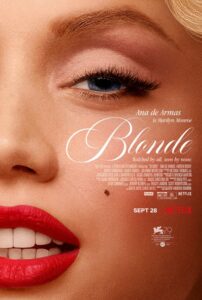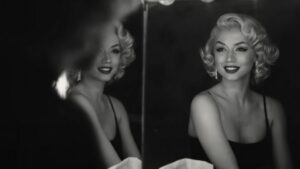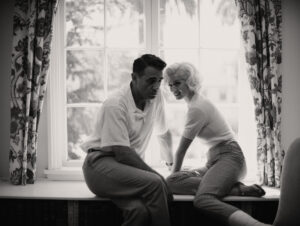The “Blonde” With Marilyn Monroe’s Face [Review]

Title: “Blonde”
Release Date: 2022
Director: Andre Dominik
Cast: Ana de Armas, Adrien Brody, Bobby Cannavale, Xavier Samuel, Julianne Nicholson, Evan Williams
The figure of Marilyn Monroe has lived to see a plethora of biographies and many film portraits, hence it is extremely difficult to find any revealing perspective on the legendary Hollywood star. Andrew Dominik therefore decided to go the route of formal innovation. Did MM’s very specifically told story work out for the plot? Both yes and no. I found the séance tiresome, at times boring and at times shock-inducing, but perhaps that’s why it was memorable. Certainly, there is a lot of sadness and suffering here, from which the film does not give us a moment’s respite, and yet we all have before our eyes the star’s captivating, immortal smile.
Why did the filmmakers choose this particular perspective? Well, I think Dominik doesn’t want to tell the story of Marilyn Monroe at all, his intention is to present the story of Norma Jeane Mortenson, the titular blonde, who created the greatest acting creation of all time – the crowd-pleasing MM. Although the film does not pretend to be a faithful biography, it is this disconnect between the real person and the Hollywood icon that, for me, is the crux of the picture.
“Blonde” – once again about MM
“Blonde” is not a classic biographical story, but a sequence of successive episodes from the life of the legendary Marilyn Monroe. Here in the opening scene of the film we see little Norma Jeane, whose mother decides to make a special gift on the occasion of her birthday. The woman raising her daughter alone reveals that the girl has a father, a man with a mysterious identity, and the proof of his existence is to be an old photo of a man in a hat and coat. From now on, Norma will want to find her real father, but she will also look for him in any man who promises her love and care. Especially since her mother, who has serious mental problems, will soon end up in a psychiatric hospital, and the girl will meet the fate of growing up without parents.

Why did the filmmakers choose this particular perspective? Well, I think Dominik doesn’t want to tell the story of Marilyn Monroe at all, his intention is to present the story of Norma Jeane Mortenson, the titular blonde, who created the greatest acting creation of all time – the crowd-pleasing MM. Although the film does not pretend to be a faithful biography, it is this disconnect between the real person and the Hollywood icon that, for me, is the crux of the picture.
“Blonde” – once again about MM
“Blonde” is not a classic biographical story, but a sequence of successive episodes from the life of the legendary Marilyn Monroe. Here in the opening scene of the film we see little Norma Jeane, whose mother decides to make a special gift on the occasion of her birthday. The woman raising her daughter alone reveals that the girl has a father, a man with a mysterious identity, and the proof of his existence is to be an old photo of a man in a hat and coat. From now on, Norma will want to find her real father, but she will also look for him in any man who promises her love and care. Especially since her mother, who has serious mental problems, will soon end up in a psychiatric hospital, and the girl will meet the fate of growing up without parents.
The adult Norma will want to prove to herself and the world that she deserves recognition and love, and the best way to do this will turn out to be acting. The difficult and sacrificial road to fame leading not only through acting schools, but also sexual relationships with repulsive, but important men in show business, will quickly take its toll on the psyche of a sensitive girl. Nor will her subsequent divorce-ending marriages to baseball player Joseph DiMaggio (Bobby Cannavale) and famous writer Arthur Miller (Adrien Brody) bring her happiness. Norma’s suffering will be compounded by lost pregnancies, and a humiliating affair with the US president (Caspar Phillipson) will spill the blackness of bitterness….
“Blonde” – MM’s life frozen in frames
“Blonde” by Andrew Dominik has no ambition to create a faithful biography of the star. The script is based on the novel by Joyce Carol Oates, which is more of a literary variation on MM’s biography, moreover, the episodic, fragmented nature of the plot indicates the director’s shunning of the form of a coherent story. Therefore, instead of a continuous, traditional narrative, we have a succession of images, which in themselves are the film’s greatest asset for me. The handling of the succession of filming techniques is not so much a formal show-off as a treatment rich in meaning and story.

Each shot of Marilyn Monroe opening an episode from her life has been stylized into authentic, famous photographs. MM in a black turtleneck and white pants, the actress with Joe DiMaggio at the window ( a photo by John Vachon), shots of MM and Arthur Miller announcing their engagement, or MM’s famous last session by the sea, shot by George Barris – all these images were precisely reproduced in the film. A peculiar animation technique was used here – an initially still frame taken from a famous photograph is animated to show the viewer some story hidden beyond it.
And it’s usually a story that contradicts the idealized message intended for the media. For example, as we listen to a conversation between MM and her spouse captured in an unseemly poetic frame against a window, we learn that a poem specially written by Norma for her husband, is scolded by him in a dismissive and plaintive manner. The fairy tale is being destroyed before our eyes, and the gap between the image of the star created by the media and her real life begins to widen.
“Blonde” – the story of an eternal icon or an ordinary mortal?
The year 2022 in cinema has resulted in an interest in biographies of great stars, as alongside “Blonde” there is a film about the king of rock’n’roll Elvis Presley. However, while Baz Luhrmann in “Elvis” focuses on the singer’s stage phenomenon, Andrew Dominik is interested not in MM’s familiar face, but in the Norma behind it. According to his vision, one can even talk about two completely different people here. The relationship between Norma and Marilyn is reduced in “Blonde” to a bond between the actress and her perfectly played role. MM functions in the film not only as a Hollywood creation, but also as a character that is deeply alien to the nature of her actress. Norma does not identify with her public image, she always refers to Marilyn Monroe as “she,” she is not even touched by letters from people containing hateful words, because she states that they are not about herself, but “this Marilyn.”
The climactic scene showing this rift, on the other hand, is the one when the crying and shaken actress, seemingly completely incapable of normal functioning, after putting on make-up looks in the mirror and in an instant transforms before our eyes into a smiling and happy star. We are clearly dealing with a stage metamorphosis, the actress gets into her role and knows how to play it perfectly.
This is the director’s way of explaining the fundamental paradox of the MM phenomenon, which has always frustrated her admirers, namely, how such a sensitive person, struggling with terrible inner problems, could simultaneously achieve so much in a world completely devoid of empathy. And I have a feeling that the film suggests that MM’s creation didn’t just destroy her, as used to be believed, but allowed the fragile Norma to survive for a long time because it was a ready-made identity in which she felt safe. In “Blonde” there are repeated scenes showing that the heroine feels lost in real life, because here, unlike in the movie, there is no ready-made script and one has to improvise constantly.

Who is the “Blonde” played by Ana de Armas?
Who, then, is the titular “Blonde Girl” played so devotedly by Ana de Armas? The very title dispensing with the star’s nickname suggests that this is the story not so much of a phenomenon, but of a girl one of many – just a blonde. On the other hand, the word functions in culture in a specific context as a term for a beautiful but not very bright woman. In this way, the filmmakers evoke a hurtful stereotype about MM, but not to reproduce it, on the contrary.
It should be emphasized that Norma from Dominik’s film is a person who with her erudition and intelligence dazzles Arthur Miller himself, one of the greatest American writers. She is the one who “plays out” the character of Magda from his play. Norma is well-read in classical literature, although completely disregarded by filmmakers engaging her in the most schematic roles. When, at one of the castings, she begins to spin an analogy between the character she plays and the characters of Fyodor Dostoevsky’s prose, the men do not believe that the actress knows the works of this writer, and they are more interested in the girl’s “great ass” than in her excellent acting.
Marilyn’s subsequent screen roles, which bring her immense popularity, are, moreover, treated as secondary in the film. For the most important creation is herself: the impeccably beautiful MM, a myth woman adored by millions of people around the world. Despite poor scripts, she manages to create the most perfect role of all time. I have to admit that in this aspect I was really impressed by the structural frame of “Blonde.” After all, the first frame shows the moment of activating the film’s spotlight, the light of which falls on the beautiful MM in the memorable scene from “The Seven Year Itch”, when the breeze from the subway blows her white dress away, showing her perfect legs.
The last scene of the film is also shot in white and once again we see the woman’s legs, but this time they are the motionless feet of the dead MM lying in white sheets on a bed. These two images clearly correspond to each other, but the second image no longer has anything to do with erotic carnality, rather it is a tormented body, evoking passionate meanings. The camera moves still, and the spotlight slowly fades out until it leaves the viewer in total silence and darkness. Norma dies, but the immortal star Marilyn Monroe is born, shown in a telling frame when the figure of the dead MM is split: one has her eyes closed, and the other turns to look at the viewer, radiating happiness. It is only then that Marilyn Monroe freezes in a perpetual smile, but the story of the smiling MM is material for a completely different film.
